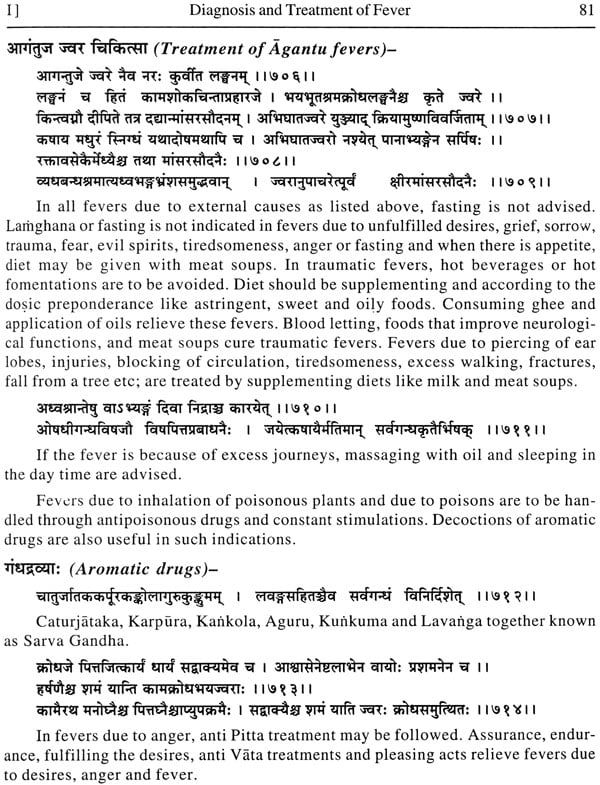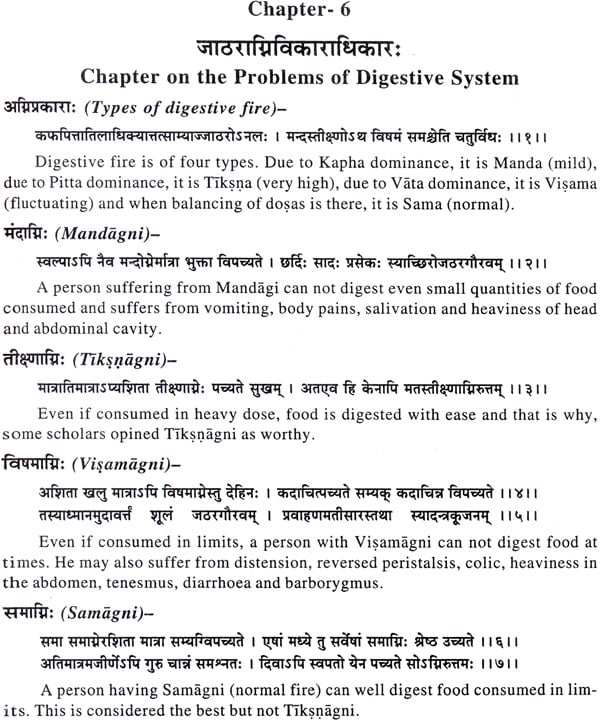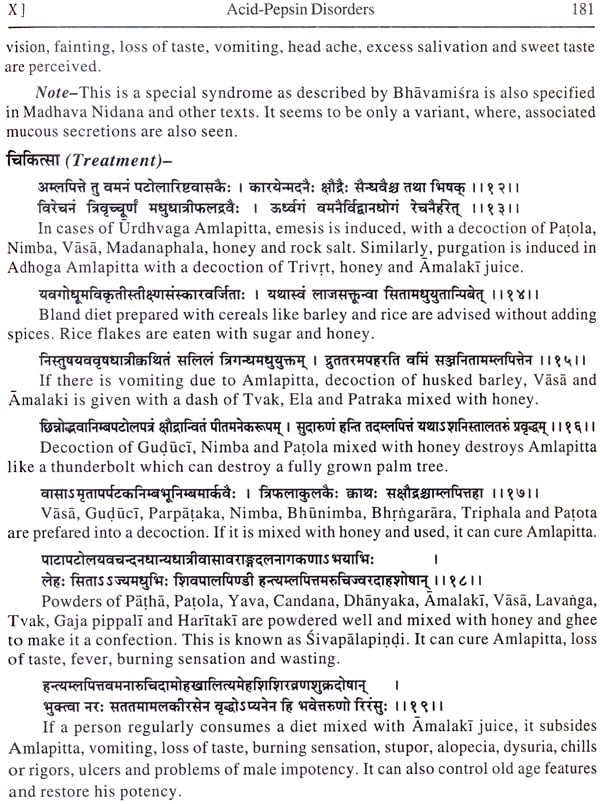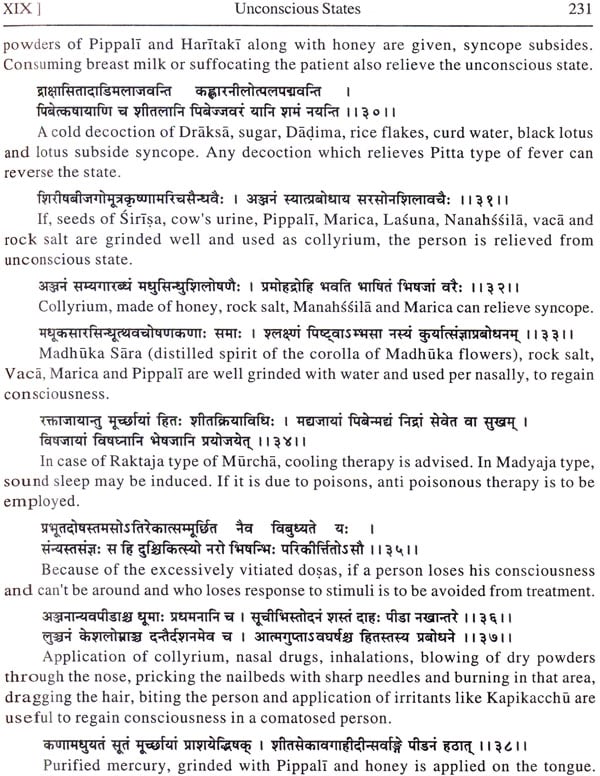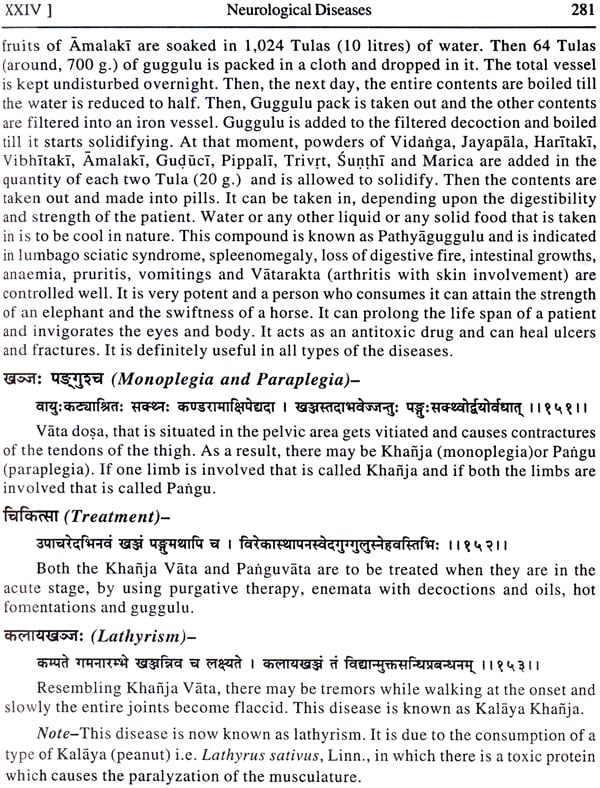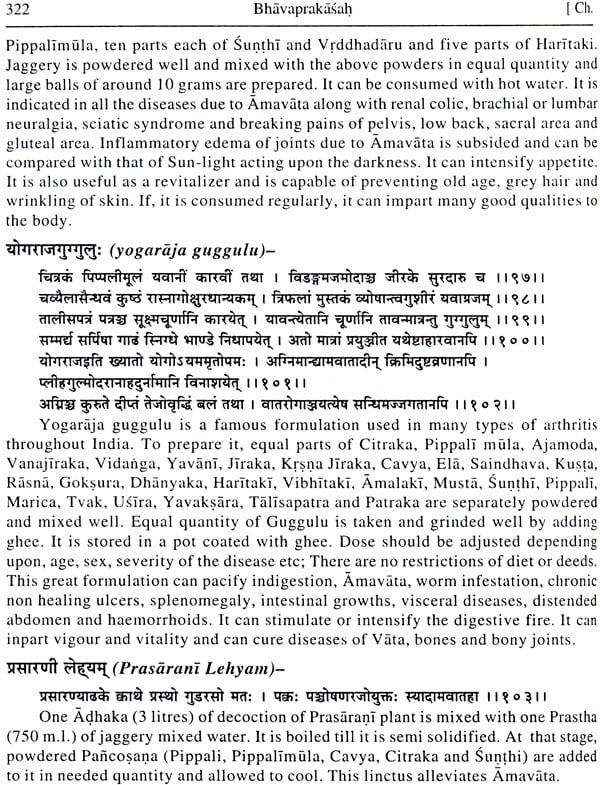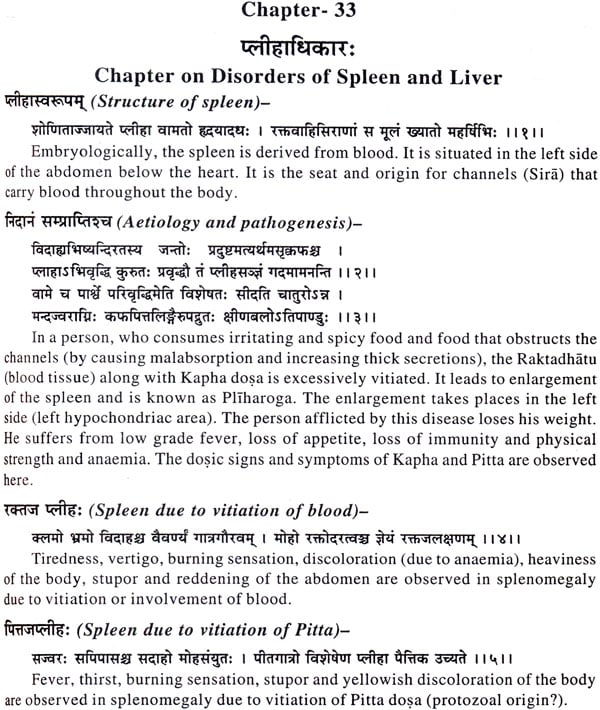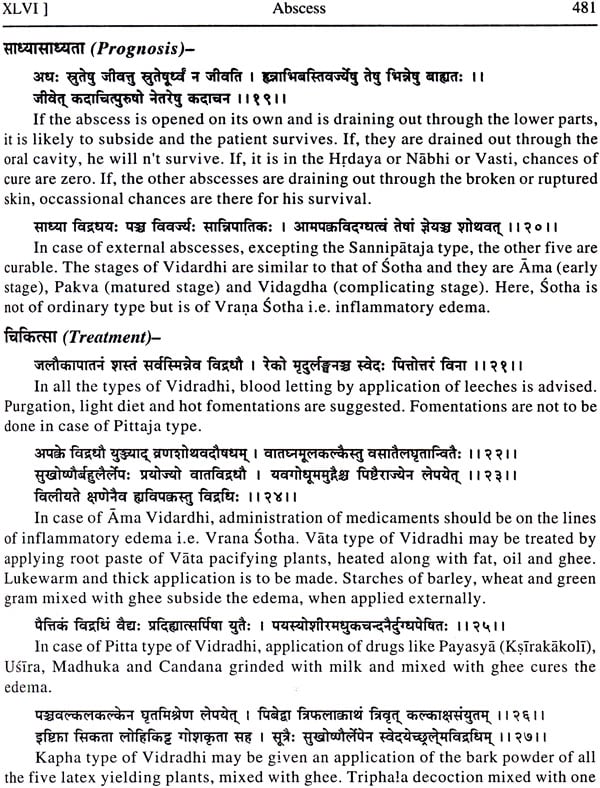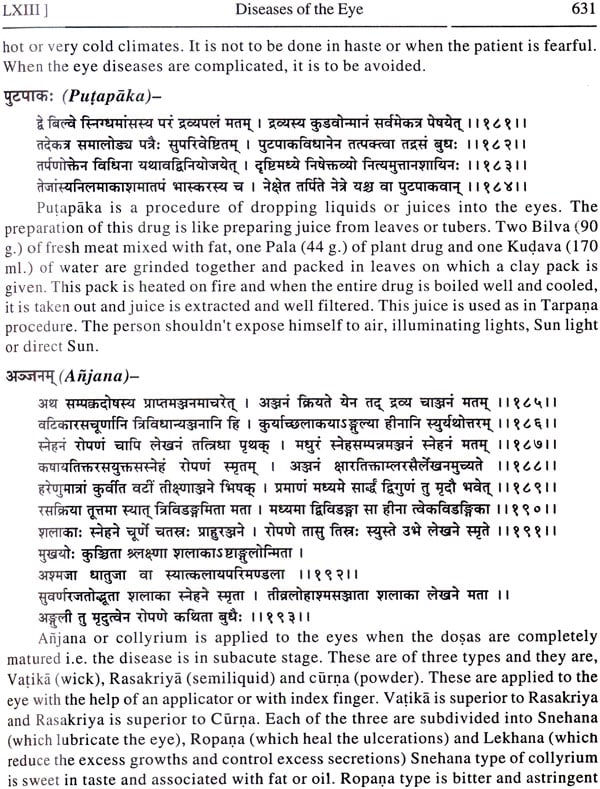
Bhavaprakasa of Bhavamisra (Vol. II)
Book Specification
| Item Code: | NAC114 |
| Author: | Dr. Bulusu Sitaram |
| Publisher: | CHAUKHAMBHA ORIENTALIA, Varanasi |
| Language: | Original Text Along with Commentary and Translation) (Madhyama and Uttara Khanda) |
| Edition: | 2010 |
| ISBN: | 9788176372060 |
| Pages: | 783 |
| Cover: | Hardcover |
| Other Details | 10.0 inch X 7.5 inch |
| Weight | 1.44 kg |
Book Description
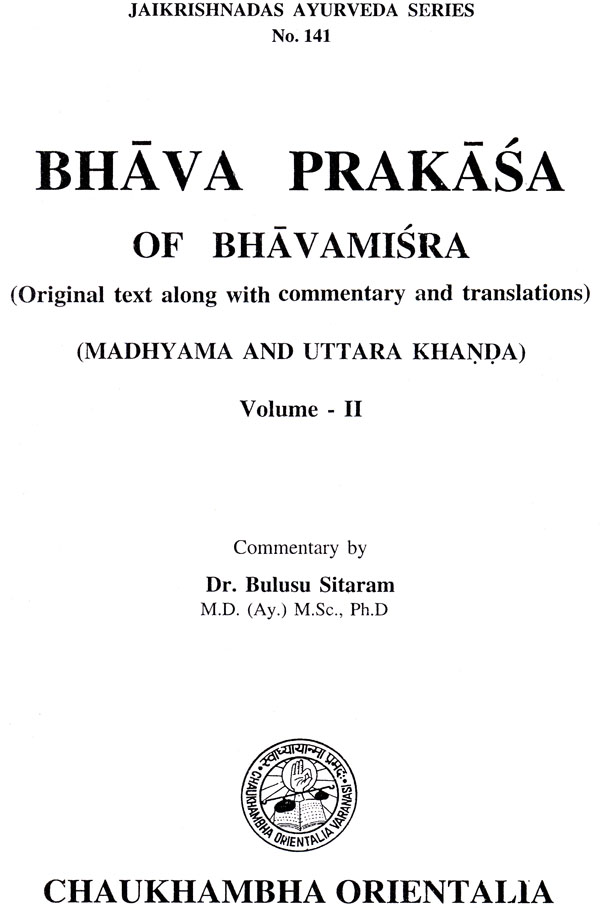
Dr. Bulusu Sitaram is from a traditional Vedic family from Inavally, situated in the Godavari delta, known as Konaseema in Andhrapradesh. He is born at Kakinada in East Godavari district on 01. 10. 1959.
His school education was at Kothapeta and completed his B.A.M.S in 1982 from Nagarjuna University in Vijayawada with a first class and first rank in the University. He completed M.D (Ayurveda) from Banaras Hindu University, Varanasi, in 1985 under the pioneer guidance of Prof. Krishna Chandra Chunekarji, a living legend in the field of Dravyaguna. He had also the opportunity to work under Prof. Ramaharsh Singh, the first Vice Chancellor of Rajahsthan Ayurveda University. He completed his Post Graduation in psychology from S.V. University in 1999.
He worked for 3 months under a team of Taxonomists in Neelagiri area. Then, he served as a medical officer for one year in a traditional Ayurvedic Hospital, Chennai. He joined as a lecturer in Sri Venkateswara Ayurveda College, Timpati in the year 1987. He is now serving as an Assistnat professor in the same institution and is also engaged in research work on Andhra medicinal flora and pharmacological studies.
He received two gold medals from Nagarjuna University for his meritorious career in B.A.M.S.
The author had the opportunity to participate in many work shops and seminars at Regional, National and International levels and presented several research papers. He had visited the forests of entire South India and some parts of North and North East.
He published more than 12 papers in different journals and authored a work on cultivation of medicinal plants. He has also translated and wrote a commentary on Bhavaprakata Purva Khanda and Astanga Hrdaya Sutrasthana. His field of interest is plants working on central nervous system. He also served as an executive editor of Ayurvedic journal AAMRA.
Bhavaprakasa is a landmark in the history of Ayurvedic Medicine. It is one of the three famous books on Ayurveda, together known as Laghutrayi. The author, Bhavamitra wrote this treatise in century AD. This was one of the best compilations of medical knowledge, prevalent in medieval period on the use of medicinal plants and treatment of various diseases. This volume comprising Madhyama and Uttara khandas i.e., 2nd and 3rd parts, contains a lot of information on the treatment aspects both medical and surgical. He clarified many thoughts on the principles of treatment and included the description and treatment of new diseases and exemplified many common diseases thus making it an esteemed treatise for academicians and physicians of Ayurveda. He has also added some new formulations and treatment methods, dwindling its importance.
The present commentary on the text is first of its kind in English. An essence of the treatment principle is given in a proper order. Comparison with the modem day medical diseases is done using the updated terminology so that no confusion arises in understanding the disease in terms of the modem view. It is surprising to note that, classification of certain diseases specifically in E.N.T and ophthalmology made by Bhavamitra appears to be more advanced than that of the modem science. Wherever necessary, a notes is given, discussing the different opinions of various commentators and in many instances, a coordinating solution is worked out. This is an informative and fundamental work useful for students, researchers and pharmacists written in an innovative and modern scientific manner. This commentary will be widely welcomed by students and practitioners of modern medicine and by scientists, interested in the vast extent and rich content of the pharmacopoeia of Ayurvedic science. A legible translation of the original text helps persons to understand the charm of Ayurveda in the middle ages.
“May Lord Venkateswara, an incarnation of Sri Maha Visnu who is the presiding deity at Tirumala which is Vaikuntham on earth, shower his blessings on all of us”
Ayurveda descended on earth more than three millenniums ago, with the great Tapas, made by seers like Bharadvaja for the welfare of the mankind. Infect, Ayurveda came into existence along with Veda and was expressed by Lord Brahma. He preached this treasure o many great persons like Dakaprajãpati. Ever since, Ayurveda continued to be in practice by divine physicians like Agwins. From them, it spread to all parts of the universe. In this mighty time, many pious and devoted physicians and seers recorded their knowledge in the form of different Samihitas. According to Pãnini, a great grammarian, Samhita means, a great precious collection of valuable knowledge. When India was invaded by foreign forces and whenever natural calamities occurred, some treatises might have been distorted, but, devoted physicians never allowed a break in the continuity of the tradition. Thus, inspite of great hurdles, the Brhatrayi (greater triad) i.e., Caraka Samhita, Suruta Samhita and Asanga 1-lrdaya inspired the entire country in learning the science and latter physicians ventured to write many wonderful texts on Ayurveda. This not only led to further development but also protected it from the danger of stagnation. These scholars went on adding their own observations and started recording them in perfect order, without deviating themselves from the basic principles, as descended from Lord Brahmadeva. In continuation of the great path of knowledge, three more treatises appeared and became famous with the name of Laghu Trayi (smaller triad) and they are, Madhavanidana, Sarngadhara Samhita and Bhava Prakasa. Out of them, Madhava richly contributed to the field of pathology and diagnosis. Sarngadhara completely revolutionized the pharmaceutics, which he felt the need of the day and this neat work paved way to the modern pharmaceutical industry.
Similarly, four hundred years back, Bhãvamisra, a versatile scholar in Ayurveda and ‘their contemporary sciences wrote a treatise, which became famous with the name of Bhavaprakasa Samhita. This work contains almost all the traditions starting from Lord Indra and seer Bharadväja. It is now, a mega bridge between the old treatises and new thoughts and applications because already by that time, Europeans started influencing our culture and knowledge.
Lie and works of Bhavamisra
Bhavamisra himself wrote that, the main purpose of his work to compile the ideas from his predecessors is to dispel darkness of ignorance on medicine. He himself told that, from a scholarly family, belongs to Brahmana community and his father’s name was Latakana Misra. Though, he has not mentioned his native place, some scholars say that, he acgs to either Varanasi or Kanyakubja. Sarma, P.V., stated that, he might belong to Gaya in Bihar state, considering the mention made by him towards Vishnupãda (Sripatipãda) where, a famous temple dedicated to the lotus feet of Lord Vishnu is present. Historian, Julius joly reported that, he found a manuscript of Bhávaprakasa in Tubingen of West Germany which belonged to 1558 AD. He was mentioned by Trimal Bhatta in his Brhadyoga Tarangini, which belonged to 1650 A.D. Hence, Bhavamisra might have lived between 1530 and 1600 A.D. Bhavamisra is said to have written four books in his life time. They are,
Bhävaprakasa - The present work, which brought fame and name to him had contributed a lot in the field of Ayurveda and is published in many languages.
Gunaratnamãla - Not yet published but the manuscript is available in some Libraries.
Tippani or Short Notes on Mädhavanidana - Only manuscript available but is not yet published.
Vaidya Nighantu - Not found any where but may be his preliminary work, used as a basis to write the Nighantu part.
Commentaries on Bhãva Prakasa
Presently, two commentaries on Bhãvaprakasa are known and the first one is published along with the text. Author of this commentary might be Bhavamisra himself or a scholar from some of his close disciples. Contradiction of the original text is not at all observed in the commentary. Unlike other commentaries like Dipika of Cakrapäni, it is very much precise using limited words in simple language. We can find good number of quotations, relevant to the context, supporting, explaining and providing additional information particularly about drugs and formulae, wherever needed. According to Sarma, P.V., another commentary in the form of manuscript is available in the university library of Jammu, which was written by Jayadeva, son of Jayakrishna Ranavira Simha, during the 18th century, which entitled “Sadvaidya Siddhãnta Ratnakara.”
Around forty years back, in the year 1969, Chunekar, K.C., a legendary person in Dravyaguna Vijnãna of contemporary times, wrote a commentary in Hindi language to the Nighantu part, which is par excellence. He was a close disciple of Thakur Balwant Singh, a great taxonomist and scholar admirer of Ayurveda. This commentary resolved many controversies and discussed in detail about each and every name, mentioned in that part.
Editions and Translations
The first known publication of Bhavaprakasa, along with its commentary was done by Sri Jivananda Vidya Sagara Bhattacharya in the year 1875 A.D. from Calcutta. Latter, Lala Saligram Vaidya has written a translation and short commentary on the entire text which was published in 1906 A.D. by Khemraj Srikrishnadas from Bombay. Then, Lalchandra Vaidya wrote a commentary in Hindi as long back as 1930 A.D. Brahma Sankar Misra made a translation of the entire text in 1969 A.D. It was translated and published in Telugu language in 1936 A.D. by a famous Vaidya, Sri Mukkamala Venkata Sastry.
Scope and Contents of the Text
Bhavaprakasa Samhita is a comprehensive work written in an elegant style and simple language. 1-fe never tried to exaggerate or overstate his scholarly attitude. The entire text is on the lines of ancient texts, containing the entire requisite information and instructions for a student of Ayurveda. Here and there, he has used Anupraa (verbal embellishment) and fine poetic language. He has touched practically all the aspects and added new information based on the knowledge and traditions of that age as well as his own experiences. As a scholar and physician, he made use of the commentators and faithfully acknowledged them by name, wherever he quoted such. He was acquainted with all the important works of Ayurveda and allied sciences like Bhatrayi, texts on Rasãstra like Rasendra Mangala and Rasa Ratna Samuccaya, commentaries of Cakrapani and Jejjata along with Brhatsamhita cf Varahamihira and Vishnu Dharmottara Purãna.
The clarity present in his style of presentation, excellence of arrangements, systematic classification of drugs and diseases, has illuminated and resolved many obscure and disputed passages of the ancient writers and his important compilation marks the last revival of old Ayurvedic literature and is considered as a thesaurus of all the useful information reaped from the vast field of millenniums old Ayurvedic literature.
The total text, divided into 3 parts, Purvakhanda, Madhyamakhanda and Uttarakhanda (sections 1,2 and 3) contains around 10,268 verses, number of which varies slightly from edition to edition and manuscript to manuscript. It is further divided into 7 pasts and 80 chapters.
Purvakhanda (Section-I) contains 7 chapters. The first five chapters dealt with the oriigin of Ayurveda and basic principles including anatomy, physiology, daily and seasonal routine, principles of pharmacology, collection of herbs and drug substitutes. The sixth part constitutes examination of the patients, principles of treatment in brief. The major part contains Nighantu in which, he described nearly 500 plant drugs, 20 mineral drugs and 4 to 5 animal products. For each drug, he gave synonyms, local name(s), properties / qualities rd therapeutic applications. At many places, he tried to clarify the identification of a particular plant species. The seventh chapter contains methods of panchakarma including Purvakarma.
Madhyamakhanda (Scction-2) has got 71 chapters, in which, he detailed different diseases with treatment aspects adding his own experiences and allotting his predecessors where ever necessary. He could diagnose syphilis as Phiranga Roga, which was brought to India by Portuguese merchants. He treated that disease using Copacini and Rasakarpüra. Utilization of Rasakarpura was taken from Portuguese, which they learnt from Chinese physicians. In the compound preparations, he elaborately utilized vegetable, metallic and animal products and made good use of the compounds.
Uttarakhanda (Section-3) dealt with Rasayana (Rejuvenation therapy) and Vajikarana (Aphrodisiacs or drugs which relieve sterility).
Retarding the Present Commentary
As mentioned earlier, there are many translations and commentaries available in different languages on Bhavaprakasa. Any how, only some could accomplish the purpose and some remained as mere translations and that is the reason, I have ventured to write a detailing work, which may be considered as commentary. The system of Ayurveda i.e., sacrifice of life originated from the vision of seers who have got great spiritual knowledge by refining existing herbal medicine gained through thousands of years of clinical experience. So, Ayurveda is probably, the oldest, the most visionary and the most developed medical system in the world and needs no commentary but needs only correct interpretation and adaptation.
Though, this translation is faithful to the text, I took some freedom when the context is not clear, taking help from the commentary. I have tried to present the underlying context in a legible language. Difficult words and poetic language are particularly avoided as to make the text understandable by all.
Here, some salient features of the treatment part of Bhãvaprakasa are given here to understand the greatness of Bhãvamisra comprehensively.
1. Nidana Pancaka has been given mostly according to Mãdhava Nidäna, but Bhavamisra’s arrangement is more scientific than that of Mãdhava. The order of five Nidãnas in Madhava’s work is Nidãna, Samprãpti, Pürvarupa, Rupa and Upasaya where as Samprãpti has been given the last place by Bhãvamisra.
2. Nidãna is defined well in Bhãvaprakãsa while it is not present in Mãdhavanidãna. Nidana is defined as a specific entity, without which, a disease can not originate.
3. Thirteen types of Sannipäta Jvara have been described including Karkataka. In such cases where permutations and combinations of Dosas are not perceivable, the physicians are advised to act on general principles.
4. Disease of Pitta and Kapha have been described in separate chapters on the analogy of diseases of Vata as in Rasendra Sara Samgraha.
5. Apart from Udararoga, a separate chapter has been devoted to liver and spleen diseases as in Rasendra Sara Samgraha.
6. After Medoroga, its contrary Karsya Roga has been described in a separate chapter.
7. In addition to Upadamsa, a separate chapter has been devoted to a new venereal disease, termed as Phiranga (Syphilis). The name is based on its origin due to contact of Phirangis (Europeans) and sexual contact with such women. Rasakarpura having mercury is prescribed as the main drug for its treatment. Rasakarpura has been described in Rasaprakasa Sudhãkara and Rasendra Sãrasathgraha with indications in leprosy and venereal diseases respectively. Basing on these traditions, Bhavamigra has indicated this drug in Syphilis.
8. Sitala i.e., small pox along with its religious treatment with stotra has been described in the chapter on Masurika. This has been taken from Käsikhanda. Even today, temples of Goddess Sitala are worshipped in and around Varanasi.
Thus, Bhvamisra is an important landmark in the History of Indian Medicine. He is the last author in Laghutrayi of Ayurveda and the first one in the modem age. He occupies the same place in Ayurveda or Indian Medicine as Bhattoji Diksita in Sanskrit Grammar, Jagannadha Panditaraja in Poetics and, Madhusudana Sarasvati in Advaita philosophy. In e terestingly all these four great persons lived in and around Varanasi and almost in the same period.
Acknowledgements
This work became possible only with the divine blessings of Sri Siddhivinäyaka Swamywho is worshipped at inavally, East Godavari District, Andhra Pradesh on the banks of River Godavari, which is our ancestral place. I pray to him to be with me throughout my life and guide me in all aspects of my life. Hence, I dedicated this work whole heartedly to His Pious Lotus Feet. Next to god, I am privileged to respectfully salute my parents Sri Buluru Satyanarayana Murty, Retd. Principal and Smt. Venkatalakshmi and they are still supporting me in all aspects with their inborn affection. My wife Smt. Apama, daughter Chi. Susinita and son Chi. Satya Sri Harsha deserve special thanks for their moral support. I am indeed lucky to live in a place like Tirumala-Tirupati which is an abode of Lord Venkateswara an incarnation of Sri Mahavishnu, whom I pray to shower his blessings upon all of us for ever. Sri Atul Kumar Gupta of Chaukhamba Orientalia maintained friendly relationship and encouraged me in writing this commentary and came forward to publish it. His constant effort to make this work exemplary is highly appreciable and I am always beholden to his sincerity.
Now, I desire to conclude this epilogue with the pious and precious words of Sri Madhusudana Sarasvati, a 16th century Advaita Vedantin, who lived in Varanasi and was a contemporary of Bhãvamira. He says in the 2nd canto of his famous work Advaita Siddhi.
I have compiled the thoughts and expressions of my teaches along with the contributions of standard texts and hence either the qualities or trivialtives are not mine. But what all presented here is my perseverance sharpened with my ability or intelligence in collecting and recording the traditions logics and preaching of my esteemed seniors.
| I | Introduction and Acknowledgements | |
| II | Schema of Transliteration | |
| III | Contents | |
| | ||
| 1 | Jvaradhikara (Diagnosis and treatment of fever) | 1 |
| 2 | Atisaradhikara (Diagnosis and treatment of Diarrhea) | 102 |
| 3 | Jvaratisaradhikara (Diagnosis and treatment of fever) | 117 |
| 4 | Grahnirogadhikara (Chapter on Dysentery) | 119 |
| | ||
| 5 | Arsodhikara (Chapter on Haemorrhoids) | 128 |
| 6 | Jatharagni Vikara (Problem of Digestive system) | 143 |
| 7 | Krmirogadhikara (Worm Infestation) | 159 |
| 8 | Panduroga, Kamala Halimaka (Anaemia Jaundice and Cirrhosis) | 163 |
| 9 | Raktapittadhikara (Haemorrhagic Diseases) | 170 |
| 10 | Amlapitta and Slesmapita (Acid Pepsin Disorders) | 179 |
| 11 | Ksayarogadhikara (Tuberculosis) | 184 |
| 12 | Kasorogadhikara (Cough and Related Diseases) | 195 |
| 13 | Hikkarogadhikara (Chapter on Hiccough) | 201 |
| 14 | Svasarogadhikara (Dyspnoea and Related Diseases) | 204 |
| 15 | Svarabhedadhikara (Voice Disorders) | 210 |
| 16 | Arocakadhikara (Loss of Taste Perception) | 213 |
| 17 | Chardyadhikara (Gastritis or Vomiting) | 217 |
| 18 | Trsnadhikara (Thirst or water Deplection) | 222 |
| 19 | Murchadhikara (Unconscious States) | 227 |
| 20 | Madatyayadhikara (Chapter on Alcoholism) | 233 |
| 21 | Dahadhikara (Burning Sensation on Neuritis) | 244 |
| 22 | Unmadhadhikara (Neuropsychotic Conditions) | 247 |
| 23 | Apasmaradhikara (Convulsive Disorders) | 258 |
| 24 | Vatavyadhyadhikara (Neurological Diseases) | 262 |
| 25 | Urustambhadhikara (Rigidity of the Thigh) | 306 |
| 26 | Amavatadhikara (Inflammatory Arthritis) | 312 |
| 27 | Pittavyadhyadhikara (Diseases Due to Pittta Dosa) | 327 |
| 28 | Slesmavyadhyadhikara (Diseases due to Slesma Dosa) | 330 |
| 29 | Vataraktadhikara (Arthritis Involving Skin) | 332 |
| | ||
| 30 | Suladhikara (Colic/Spasmodic Abdomen) | 358 |
| 31 | Udavartadhikara (Reversed Peristalsis) | 370 |
| 32 | Gulmadhikara (Growths of Viscera) | 377 |
| 33 | Plihadhikara (Spleen and Liver Disorders) | 385 |
| 34 | Hrdrogadhikara (Diseases of the Heart) | 388 |
| 35 | Mutrakrchradhikara (Painful Micturition ) | 399 |
| 36 | Mutraghatadhikara (Retention of Urine) | 399 |
| 37 | Asmaryadhikara (Urinary Calculi) | 408 |
| 38 | Pramehadhikara (Diseases of Urinary Tract and Diabetes) | 419 |
| 39 | Medorogadhikara (Obesity and Related Diseases) | 436 |
| 40 | Karsyadhikara (Wasting Disorders) | 445 |
| 41 | Udaradhikara (Enlargement of Visceral Organs) | 447 |
| 42 | Sothadhikara (Tissur Edema) | 456 |
| 43 | Vrddhi Bradhnadhikara (Scrotal and Inguinal Swellings) | 462 |
| 44 | Galaganda Gandamaladhikara (Swelling and Growths of Different body parts) | 467 |
| 45 | Slipadadhikara (Filarisis) | 476 |
| 46 | Vidradhyadhikara (Chapter on Abscess) | 478 |
| 47 | Vranasothadhikara (Inflammatory Edema) | 483 |
| 48 | Bhagnadhikara (Bone Fractures) | 497 |
| | ||
| 49 | Nadivranadhikara (Sinus Ulcers) | 505 |
| 50 | Bhagandaradhikara (Fistula-in-ano) | 511 |
| 51 | Upadamasadhikara (Sexually Transmitted Diseases) | 517 |
| 52 | Lingarsodhikara (Genital Warts) | 523 |
| 53 | Sukadosadhikara (Sukadosa) | 524 |
| 54 | Kustarogadhikara (Skin Diseases) | 528 |
| 55 | Sitapittadhikara (Urticaria and Skin Rashes) | 546 |
| 56 | Visarpadhikara (Skin Eruptions) | 549 |
| 57 | Snayurogadhikara (Guinea Worm Infestation) | 554 |
| 58 | Visphotadhikara (Bullous Eruptions) | 556 |
| 59 | Phirangarogadhikara (Syphills) | 560 |
| 60 | Masuradhikara (Chicken Pox and Small Pox) | 564 |
| 61 | Ksudrarogadhikar (Miscellaneous Diseases) | 574 |
| 62 | Sirorogadhikara (Diseases of Head and Neck) | 596 |
| 63 | Netrarogadhikara (Diseases of the Eye) | 604 |
| 64 | Karnarogadhikara (Diseases of the Ear) | 638 |
| 65 | Nasarogadhikara (Diseases of the Nose) | 646 |
| 66 | Mukharogadhikara (Diseases of the Oral Cavity) | 654 |
| 67 | Visadhikara (Toxicology) | 675 |
| 68 | Strirogadhikara (Abnormal Uterine Bleeding) | 686 |
| 69 | Somarogadhikara (Leucorrhoea) | 689 |
| 70 | Yonirogadhikara (Gynaecology and Obstetrics) | 691 |
| 71 | Balrogadhikara (Paediatrics) | 708 |
| | ||
| 1 | Vajikaranadhikara (Male Infertility) | 727 |
| 2 | Rasayanadhyaya (Revitalization) | 736 |
| | ||
| 1 | Animals Mentioned in Bhavaprakasa Vol.1 and Vol.2 | 741 |
| 2 | Birds Mentioned in Bhavaprakasa vol.1 and vol.2 | 744 |
| 3 | Traditional Measurements and their Modern Equivalents | 746 |
| 4 | Previous Authors Mentioned By Bhavamisra | 747 |
| 5 | Geographical Areas Mentioned by Bhavamisra | 748 |
| 6 | Word Index | 750 |
| 7 | Bibliography | 770 |

